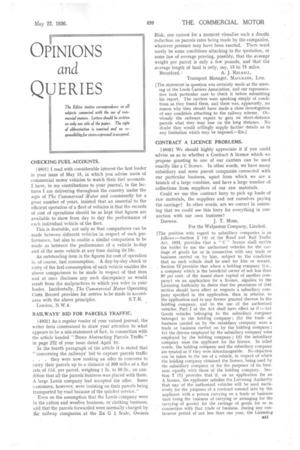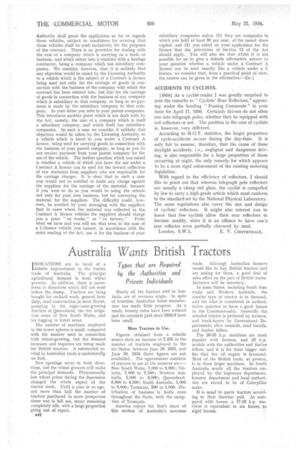OPINIONS
Page 51

Page 52

If you've noticed an error in this article please click here to report it so we can fix it.
and
QUERIES
The Editor invites correspondence on all subjects connected with the use of commercial motors. Letters should be written on only one side of the paper. The right of abbreviation is reserved and no responsibility for views expressed is accepted.
CHECKING FUEL ACCOUNTS.
(4801] I read with considerable interest the first leader in your issue of May 15, in which you advise users of commercial motor vehicles to watch their fuel accounts. I have, in my contributions to your journal, in the lectures I am delivering throughout the country under the mgis of The Commercial Motor and consistently for a great number of years, insisted that an essential to the efficient operation of a fleet of vehicles is that the records of cost of operations should be so kept that figures are available to show from day to day the performance of each individual vehicle of the fleet.
This is desirable, not only so that comparisons can be made between different vehicles in respect of such performance, but also to enable a similar comparison to be made as between the performance of a vehicle to-day and of the same vehicle at any time during its life.
An outstanding item in the figures for cost of operation is, of course, fuel consumption. A day-by-day check or entry of the fuel consumption of each vehicle enables the above comparisons to be made in respect of that item and at once discloses any such discrepancy as would result from the malpractices to which you refer in your leader. Incidentally, The Commercial Motor Operating Costs Record provides for entries to be made in accord
ance with the above principles. S.T.R. London, N.W.4.
RAILWAYS' BID FOR PARCELS TRAFFIC.
[4802] As a regular reader of your valued journal, the writer feels constrained to draw your attention to what appears to be a mis-statement of fact, in connection with the article headed "Buses Abstracting Parcels Traffic" in page 272 of your issue dated April 10.
In the fourth paragraph of the article it is stated that " concerning the railways' bid to capture parcels traffic . . . they were now making an offer to concerns to carry their parcels up to a distance of 300 miles at a flat rate of 11d. per parcel, weighing 1 lb. to 56 lb., on condition that all the parcels business was placed with them. A large Leeds company had accepted the offer. Some customers, however, were insisting on their parcels being transported by road because of the quicker service."
Even on the assumption that the Leeds company were in the cotton and woollen business, or clothing business, and that the parcels forwarded were normally charged by the railway companies at the Ex G 1 Scale, Owners Risk, one cannot for a moment visualize such a drastic reduction on parcels rates being made by the companies, whatever pressure may have been exerted. There must surely be some conditions attaching to the quotation, or some law of average proving, possibly, that the average weight per parcel is only a few pounds, and that the average length of haul is only, say, 15 to 75 miles.
Brentford. A. J. KELSALL, Transport Manager, MACLEANS, LTD.
[The statement in question was certainly made at the meeting of the Leeds Carriers Association, and our representative took particular care to check it before submitting his report. The carriers were speaking simply of conditions as they found them, and there was, apparently, no reason why they should have made a close investigation of any condition attaching to the railway scheme. Obviously the railways expect to gain on short-distance parcels what they may lose on the long distance. No doubt they would willingly supply further details as to any limitation which may be imposed.—ED.1
CONTRACT A LICENCE PROBLEMS.
P18031 We should highly appreciate it if you could advise us as to whether a Contract A licence which we propose granting to one of our carriers can be used exactly like a C licence. In other words, we have many subsidiary and some parent companies connected with our particular business, apart from which we are a branch of a large combine, and have a large number of collections from suppliers of our raw materials.
Could we use this contract lorry to pick up loads of raw materials, the suppliers and not ourselves paying the carriage? In other words, are we correct in assuming that we could use this lorry for everything in connection with our own business?
Darwen. J. T. Moss, For the Walparriur Company, Limited.
[The position with regard to subsidiary companies is as follows :—Section 2 (4) of the Road and Rail Traffic Act, 1933, provides that a " C " licence shall entitle the holder to use the authorized vehicles for the carriage of goods for or in connection with any trade or business carried on by him, subject to the condition that no such vehicle shall be used for hire or reward. Section 12 provides that where a holding company (i.e., a company which is the beneficial owner of not less than 90 per cent of the issued share capital of another company) on an application for a licence, signifies to the Licensing Authority its desire that the provisions of that section should have effect as respects a subsidiary company specified in the application, then in relation to the application and to any licence granted thereon to the holding company, and to the use of the authorized vehicles, Part I of the Act shall have effect as if :—(a) Goods vehicles belonging to the subsidiary company belonged to the holding company ; (b) the trade or business carried on by the subsidiary company were a trade or business carried on by the holding company ; (c) the drivers employed by the subsidiary company were employed by the holding company ; (d) the subsidiary company were the applicant for the licence. In other words, the holding company and the subsidiary company are treated as if they were interchangeable. No objection can be taken to the. use of a vehicle, in respect of which the holding company obtained the licence, being used by the subsidiary company or for the purposes of its business equally with those of the holding company. Section 7 (1) provides that if, on an application for an A licence, the applicant satisfies the Licensing Authority that any of the authorized vehicles will be used exclusively for the purposes of a contract entered into by the applicant with a person carrying on a trade or business (not being the business of carrying or arranging for the. carrying of goods) for the carriage of goods for or in connection with that trade or business, during any con.tinuous period of not less than one year, the Licensing Authority shall grant the application so far as regards those vehicles, subject to conditions for securing that those vehicles shall be used exclusively for the purposes of the contract. There is no provision for dealing with the case of a company which is carrying on a trade or business, and which enters into a contract with a haulage contractor, being a company which has subsidiary companies. We consider, however, that it is unlikely that any objection would be raised by the Licensing Authority to a, vehicle which is the subject of a Contract A licence being used not only for the carriage of goods in connection with the business of the company with which the contract has been entered into, but also for the carriage of goods in connection with the business of any company which is subsidiary to that company, so long as no payment is made by the subsidiary company to that coinpany. In your letter you refer to your parent companies. This introduces another point which is not dealt with by the Act, namely, the case of a company which is itself a subsidiary company, and which itself has subsidiary companies. In such a case we consider it unlikely that objection would be taken by the Licensing Authority to a vehicle which is hired to you under a Contract A licence, being used for carrying goods in connection with the business of your parent company, so long as you do not receive payment from your parent company for the use of the vehicle. The further question which you raised is whether a vehicle of which you have the use under a Contract A licence can be used for the inward collection of raw materials from suppliers who are responsible for the carriage charges. It is clear that in such a case you would not be entitled to make any charge against the suppliers for the carriage of the material, because if you were to do so you would be using the vehicle not only for your own business, but for conveying the material for the suppliers. The difficulty could, however, be avoided by your arranging with the suppliers that in cases where the material was collected in the Contract A licence vehicles the suppliers should charge you a price " ex works," or " ex factory." From what we have said you will see that even in the case of a C-licence vehicle you cannot, in accordance with the strict reading of the Act, use it for the business of your subsidiary companies unless (1) they are companies in which you hold at least 90 per cent, of the issued share capital, and (2) you asked on your application for the licence that the provisions of Section 12 of the Act should apply. You will also see that whilst it is not possible for us to give a definite affirmative answer to your question whether a vehicle under a Contract A licence can be used exactly like a vehicle under a C licence, we consider that, from a practical point of view, the answer can be given in the affirmative.—En.]
ACCIDENTS TO CYCLISTS.
[4804] As a cyclist-reader I was greatly surprised to note the remarks re " Cyclists' Rear Reflectors," appearing under the heading "Passing Comments" in your issue for April 17, 1930. Certainly drivers do not often run into telegraph poles, whether they be equipped with red reflectors or not. The position in the case of cyclists is, however, very different.
According to M.O.T. statistics, the larger proportion of cycle-accidents occurs during the day-time. It is only fair to assume, therefore, that the cause of these daylight accidents, i.e., negligent and dangerous driving, is also responsible for a large proportion of those occurring at night, the only remedy for which appears to be a more rigid enforcement of the existing motoring With regard to the efficiency of reflectors, I should like to point out that whereas telegraph pole reflectors are usually a cheap red glass, the cyclist is compelled by law to carry a high-grade article which must conform to the standard set by the National Physical Laboratory. The same regulations also cover the size and design of cyclists' reflectors. It might also interest you to know that few cyclists allow their rear reflectors to become muddy, since it is an offence to have one's rear reflector even partially obscured by mud.
London, S.W.1. E. V. CHIPPENDALE.




















































































